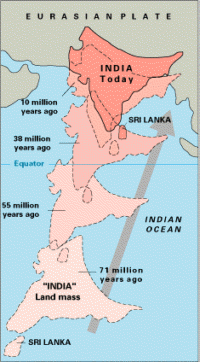 SKC Films Library |
| SKC Films Library >> Geography >> Physical Geography >> Mountains |
| The Himalaya [him' uh lA' uh] There are only six mountains more than five miles high in the entire world, and all six of them are in the Himalaya. The name Himalaya comes from the Sanskrit language and means the House of Snow, or the Snowy Range. composite satellite view of the Himalaya The Himalaya extend in a 1,500-mile curve across southern Asia from the Pamirs, west of the great bend of the Indus River, eastward to the great bend of the Brahmaputra River, forming a barrier between northern India and the plateau of southwestern China. Parts of the range are as much as 200 miles wide. map showing location of the Himalaya The system rises in steps from the plains of northern India, which have an elevation of about 1,000 feet above sea level, to Mount Everest, the highest mountain in the world, which rises 29,028 feet above sea level. Other major peaks in the Himalaya include: Godwin Austen (28,250 feet), Kanchenjunga (28,208 feet), Makalu I (27,824 feet), Dhaulagiri (26,810 feet), Nanga Parbat (26,650 feet), Kamet (25,447 feet), Makalu II (25,130 feet), and Kailas (22,028 feet). The passes that run through the Himalaya are among the highest in the world, few of them being lower than 15,000 to 16,000 feet above sea level. Most are covered with snow from November to May and are almost impossible to cross. the peak of Mount Everest, highest mountain in the
world Almost every kind of climate can be found in the Himalaya because of the great difference in altitude in various parts of the range. Tropical plants such as the fig and palm tree grow on the steep southern slopes, up to a height of 3,000 feet. Oak, chestnut and laurel trees are common up to 7,000 feet, while deodar and pine trees begin to appear at 12,000 feet. Many shrubs and climbing plants are found in the forests. Rhododendrons grow on the mountain slopes. The tea plant is cultivated up to 5,000 feet. Rice, corn, and millet are grown on the southern slopes up to 6,000 feet; wheat and barley are grown in slightly higher regions. The Himalaya is also home to an amazing array of animals, including tigers, leopards, rhinoceroses, elephants, yaks, and monkeys. A relatively new mountain range, the Himalaya began to form between 40 and 50 million years ago, when the Indian subcontinent "slammed" into the Eurasian plate. Because both of these continental landmasses have about the same rock density, one plate could not be subducted under the other. The pressure of the impinging plates could only be relieved by thrusting skyward, contorting the collision zone, and forming the jagged Himalayan peaks. And, because impinging of the two landmasses has yet to end, the Himalaya continue to rise more than 2 inches a year. At present, the movement of India continues to put enormous pressure on the Asian continent, and Tibet in turn presses on the landmass to the north that is hemming it in. The net effect of these forces is to "squeeze" parts of Asia eastward toward the Pacific Ocean. These processes produce a "domino" effect in which tremendous stresses build up within the Earth's crust, which are then relieved periodically by earthquakes along the numerous faults that scar the landscape. Some of the most destructive earthquakes in history are related to tectonic processes that began some 50 million years ago when the Indian and Eurasian continents first collided. India collides with Asia to form the Himalaya
|
| SKC Films Library >> Geography >> Physical Geography
>> Mountains This page was last updated on 10/28/2017. |
